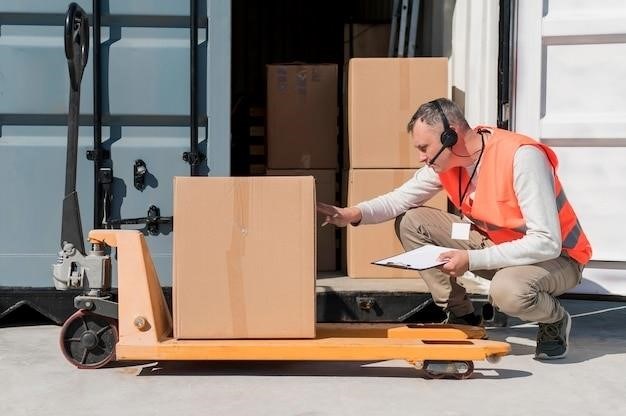Manual Dock Leveler Installation Methods
Manual dock levelers offer two primary installation approaches⁚ pit-style and exterior-mount. Pit-style involves setting the leveler into a pre-excavated pit, while exterior-mount secures it directly to the dock’s exterior, offering a space-saving alternative. Both methods ensure safe and efficient loading.
Pit-Style Installation
Pit-style installation is a traditional method for manual dock levelers. It necessitates creating a recessed pit in the dock floor, precisely matching the leveler’s dimensions. Accurate measurements are crucial to ensure a snug fit and prevent instability. Before installation, verify the pit’s depth, squareness, and dimensions against the manufacturer’s specifications. Any discrepancies should be corrected before proceeding. Once the pit is prepared, carefully lower the leveler into place, securing it firmly using the provided anchoring system. Proper anchoring is essential for safety and operational stability. Consult the installation manual for detailed instructions and safety precautions specific to your model of manual dock leveler.
Exterior-Mount Installation
Exterior-mount installation presents a modern alternative to the traditional pit-style method. This approach eliminates the need for pit excavation, saving time and resources. The leveler is mounted directly onto the dock’s exterior surface, typically secured to the existing structure using robust brackets and fasteners. Prior to installation, ensure the dock’s structural integrity can support the leveler’s weight and anticipated loads. Accurate measurements and precise alignment are critical to maintain stability and operational safety. The exterior-mount method often involves using specialized mounting hardware and may require additional structural reinforcement depending on the dock’s design and the leveler’s specifications. Always consult the manufacturer’s instructions for detailed procedures and safety guidelines.

Manual Dock Leveler Installation Manual
This manual provides comprehensive guidance for installing manual dock levelers, ensuring a safe and efficient loading dock operation. Detailed instructions and safety precautions are included for a successful installation.
Pre-Installation Checks
Before commencing installation, meticulously verify the dock’s structural integrity and ensure it can adequately support the leveler’s weight capacity. Carefully examine the installation area, confirming dimensions align precisely with the leveler’s specifications. Check for any obstructions or impediments that might hinder installation. Thoroughly inspect the leveler itself, verifying its components are undamaged and complete. Refer to the manufacturer’s provided diagrams and specifications to double-check all measurements and components. Ensure all necessary tools and equipment are readily available before starting. Addressing these pre-installation checks minimizes delays and potential issues during the installation process, resulting in a smooth and successful outcome. Confirm the pit’s depth and squareness if using a pit-style installation, correcting any discrepancies before proceeding. This preliminary step safeguards against unforeseen complications and guarantees a secure installation.
Step-by-Step Installation Guide
Begin by carefully positioning the dock leveler within the designated area, ensuring proper alignment with the dock and any surrounding structures. Securely fasten the leveler to the dock using appropriate bolts and anchors, following the manufacturer’s instructions precisely. If installing a pit-style leveler, ensure the pit’s dimensions match the leveler’s base. For exterior-mount installations, verify the mounting surface’s stability. Connect any necessary mechanical components, such as levers or handles, ensuring smooth and effortless operation. After completing the installation, conduct a thorough test run, raising and lowering the leveler multiple times to confirm its proper function and stability. Check for any binding or resistance during operation. Finally, inspect all fastening points for tightness and stability. A detailed step-by-step guide, often included with the product, is essential for successful installation, ensuring a safe and functional loading dock.

Safety Precautions During Manual Dock Leveler Installation and Operation
Prioritize safety throughout installation and operation. Never work under a raised leveler. Always ensure proper support and secure the leveler before use. Adhere strictly to weight limits to prevent accidents.
Safe Handling Procedures
Safe handling of a manual dock leveler begins before installation. Inspect the unit thoroughly upon delivery, checking for any damage incurred during shipping. Wear appropriate personal protective equipment (PPE), including gloves, safety glasses, and steel-toed boots throughout the entire installation process. Use lifting equipment appropriate for the weight of the leveler; never attempt to lift it manually unless it’s exceptionally lightweight. Follow the manufacturer’s instructions meticulously for hoisting and positioning the leveler into its designated location, whether pit-style or exterior-mount. During installation, maintain a clear communication system with your team, ensuring that everyone is aware of the movement and positioning of the heavy equipment. Remember to always secure the leveler properly once installed to prevent unintended movement.
Operational Safety Guidelines
Before operating a manual dock leveler, always visually inspect it for any damage or wear. Ensure the lip is fully extended and securely supported by the vehicle before allowing any movement of equipment. Never exceed the leveler’s rated weight capacity; overloading can lead to serious injury or equipment failure. Never leave loads unattended on the leveler. Prohibit anyone from standing on the leveler while it’s in motion or being adjusted. If the leveler is not operating smoothly or shows signs of malfunction, cease operation immediately and contact qualified maintenance personnel. Regular lubrication and scheduled maintenance, as detailed in the owner’s manual, are critical to safe and efficient operation. Always be mindful of your surroundings and maintain awareness of other personnel in the vicinity of the loading dock during operation. Follow all posted safety warnings and regulations.
Maintenance of Manual Dock Levelers
Regular inspection and lubrication are crucial for extending the lifespan and ensuring safe operation of your manual dock leveler; Addressing any issues promptly prevents costly repairs and downtime.
Regular Inspection and Lubrication
Regular maintenance is key to prolonging the life of your manual dock leveler and preventing unexpected breakdowns. A scheduled inspection should include a thorough examination of all moving parts, checking for wear and tear, damage, or any signs of malfunction. Pay close attention to the lip, hinges, and any support structures. Look for cracks, bends, or excessive rust. Ensure all nuts, bolts, and pins are securely fastened and tightened. Lubricate moving parts with an appropriate grease or lubricant, following the manufacturer’s recommendations. This will reduce friction, minimize wear, and ensure smooth operation. The frequency of lubrication will depend on usage and environmental conditions, but a monthly inspection with lubrication as needed is a good starting point. Remember, proactive maintenance saves time and money in the long run.
Troubleshooting Common Issues
If your manual dock leveler malfunctions, systematic troubleshooting is crucial. Begin by checking for obvious obstructions hindering movement. Inspect the lip for damage or misalignment; a bent lip may prevent smooth operation. Examine the chain mechanism for any kinks, breaks, or loose connections. Tighten any loose bolts or nuts securing the leveler components. If the leveler is difficult to raise or lower, lubrication may be necessary. Apply an appropriate grease to moving parts, ensuring even distribution. If the issue persists, check the leveler’s support structure for any signs of settling or damage. Uneven support can cause binding or instability. If the problem remains unresolved after these checks, consult the manufacturer’s instructions or contact a qualified service technician. Avoid attempting complex repairs without proper expertise, as improper handling could lead to further damage or injury. Always prioritize safety when troubleshooting any mechanical equipment.




Leave a Reply
You must be logged in to post a comment.